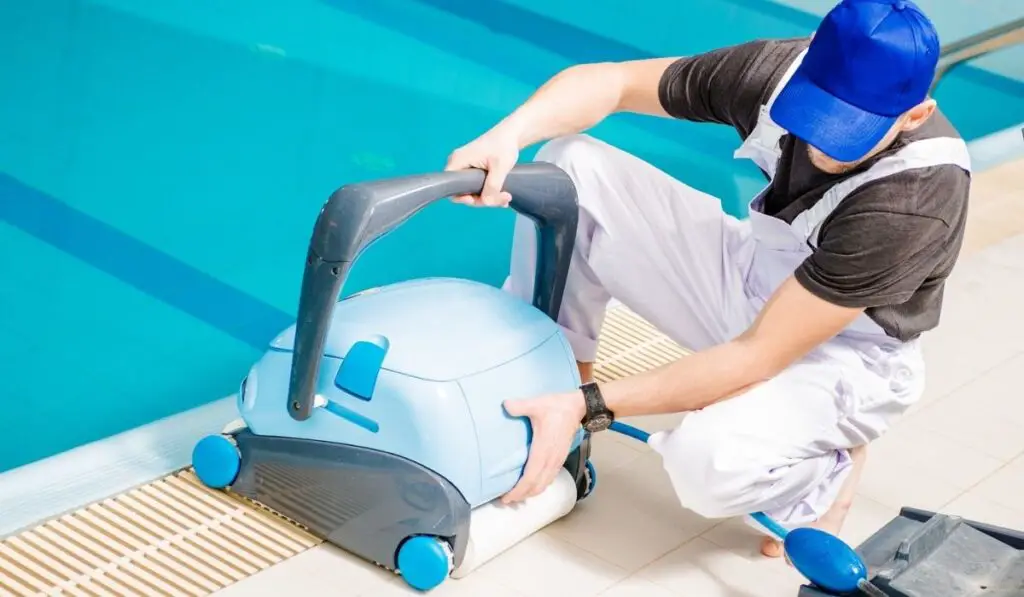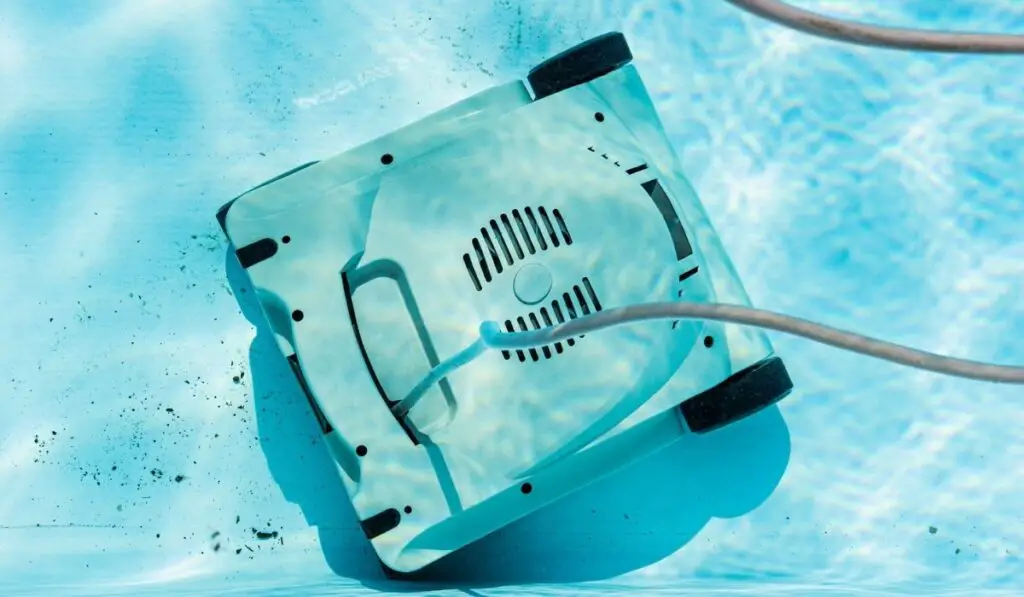Pool vacuums are one of the most convenient tools for keeping your pool in tip-top shape. They help you quickly eliminate leaves and debris that can clog up the filter and make your pool dirty. But as with all machines, you need to troubleshoot them once in a while. So, what causes problems with pool vacuums?
Pool vacuum pumps often fail to work due to issues with the power supply, connection, or the cleaner’s hose. The problems may also be due to the drive motor, improper setting of the return jets, low water levels, a clogged skimmer filter, or air getting inside the pump.
The problems and causes that arise with pool vacuums often vary widely from one vacuum type to the next, so it’s important to consider your particular vacuum type as you proceed. Let’s take a closer look at the issues that you might face, how to recognize them, and how to solve them.
Common Problems With a Pool Vacuum

If you’re facing challenges with your pool vacuum, it’s likely that the issue is one of the following:
Vacuum Isn’t Running
If the vacuum doesn’t run properly, it can cause problems with your pool water quality. This, however, shouldn’t be an issue if you have a high-quality filter pump and conduct regular maintenance.
First, check to ensure the vacuum is turned on, and check the cord to see if it has become frayed or damaged. You should then check to ensure that there isn’t any debris stuck inside the hose or filter bag that could prevent water from flowing through the system properly.
If none of those things seem to be causing the problem, then you may want to call in an expert who can look at your equipment and figure out why it isn’t working.
Suction Loss
If you notice that your vacuum’s suction has decreased, it could mean that debris has clogged up your hose or other areas of the vacuum. Remove any dirt from these areas and see if it fixes your problem.
Suction loss may also be due to low water levels, holes in the suction hose, too much debris in the skimmer basket, or the pump cover letting in air.
Dirty Water Returning to the Pool
This happens if you don’t check the filters regularly. It’s caused by the immediate use of a backwashed sand filter, as the sand will not have settled in the filter head.
Vacuum Only Works for a Short Time
Sometimes your vacuum may power on and off. The primary causes are often a blocked tube and a filthy pool, which frequently obstructs the filter.
Types of Pool Vacuums
Now that you’ve familiarized yourself with some of the most common issues with pool vacuums, let’s take a look at the different types and how they differ.
Suction Pool Vacuums
Suction pool vacuums, like the Hayward AquaNaut 400 (on Amazon), are one of the most common types of pool cleaners on the market today. These cleaners use a pump to suck up debris and other materials in your pool, including dirt, leaves, and other items that can clog its parts.
The best suction pool vacuums pick up almost anything, including leaves and small dirt particles that get into the water. They have different features that make them more efficient than other types of cleaners, and they’re affordable for most homes.
When you purchase a suction pool vacuum, make sure it has all the parts necessary to work properly in your pool environment. The central part of this type of cleaner is the suction head, which attaches to your skimmer or another location near the surface of your pool.
It sucks up debris around the surface and creates negative pressure inside your pool’s plumbing system, so that water flows easily into your skimmer basket or sump bucket.
This means that when you turn on your pump while using a suction pool vacuum, water will move through it smoothly without fighting against strong currents or turbulence caused by other objects.
Movement Problems and Solutions
The most common problem with pool vacuums is failure to move properly. This can be due to various reasons such as:
- The suction force of the pump has been weakened. This can happen if there’s a hole in the hose or some debris is stuck between the hose and the motor. If this is the case, you’ll have to replace these parts to get your pool vacuum working again.
- Something has gone wrong with your filter system, or some debris might be stuck between your filter and pool wall or floor. You must clean out all these things before using your pool vacuum again.
If your pool vacuum starts and stops, it could be due to suction levels being low. You need to increase the level by adjusting the control valve. Other solutions include checking the hammer or diaphragm and possible air leaks.
However, if the cleaner is not doing its job adequately, it may be because the return jets are pointing to the pool’s bottom. The remedy here is to redirect the jets to point upwards.
Robot Pool Vacuums
Robot Pool Vacuums are the best way to keep your swimming pool clean, especially if you live in an area with large debris. They are designed to scrub, vacuum, and filter your pool without human intervention, so you can spend time doing other things during the day.
These cleaners are energy efficient as they use their pressure for movement. Our favorite is the AIPER Cordless Robotic Pool Cleaner (on Amazon).
Movement Problems and Solutions
If a pool vacuum moves in circles, it may be a sign that the suction fittings aren’t correctly installed or in good condition. To check this, turn off the pump and remove debris from the suction fittings. If they’re damaged, replace them before turning on the pump again.
If a pool vacuum is moving in straight lines but not vacuuming up debris, it could mean that there isn’t enough water flowing through the hose to create suction. Try extending your hose to see if that helps increase its length and improve performance.
Lastly, if your pool vacuum isn’t moving at all after initial installation or setup, make sure you:
- Check the extension cord
- Test all connections for tightness
- Replace any worn parts
- Ensure there are no blockages (including dirt)
Pressure Pool Vacuums
Pressure pool vacuums, such as the Hayward TriVac 500 (on Amazon), use a booster pump to move around the pool. Water passes through its propeller, cleaning and collecting any debris.
These vacuum cleaners use water pressure from the pump to create suction that draws dirt from the bottom of the pool and into its filter bag.
This process eliminates the need for hand brushing or vacuuming, which can be very time-consuming. Some models even have adjustable suction levels and can adjust to uneven surfaces such as steps or ladders.
The suction power on these vacuums can vary greatly depending on what type you buy, but they’re generally pretty powerful machines.
Movement Problems and Solutions

If your pool vacuum is moving but not picking up debris, the problem may lie in its filter. Check if any filter parts are clogged or damaged, and replace or repair them as needed. Additionally, check both the inline and second strainer found at the fitting wall connection and near the pump.
If you can’t find anything wrong with your filter, check all your hoses for cracks, holes, and other defects that could be causing air leaks. You should then check out the pool vacuum itself in case something that might be blocking its path forward or backward has been dropped into it.
Make sure the pressure of your vacuum cleaner is above 30 PSI, as this is often the solution to a cleaner that does not move. Additionally, check that the booster and filter pumps are running correctly and that the axles and wheels aren’t blocked by debris and small particles.
There are instances where the cleaner fails to cover the entire pool. This can be resolved by adjusting the flow, thus increasing the pressure and powering it up to move more. You should also redirect the returns towards the surface, allowing the cleaner to pass below the moving water naturally.
The hose pipe may also hinder movement if it’s short. To rectify this, determine your pool’s size to give you the proper hose length. This is also crucial as it will help prevent the hosepipe from becoming tangled, which could impact the vacuum cleaner’s movement further.
Make sure the feed hose is floating and avoid using old ones as they quickly become waterlogged and cause more entanglement.
